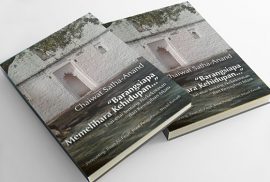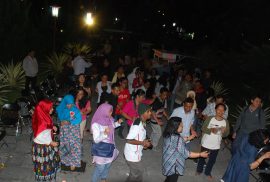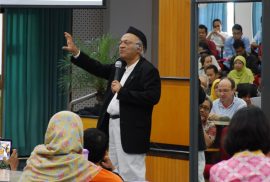Azis A. Fahrudin | CRCS | News
The writer is a graduate student of CRCS batch 2014. This article is his response to Chaiwat Satha-Anand’s compilation articles published by PUSAD Paramadina, Jakarta and his lecture at CRCS on October 8, 2015.
T he book by Chaiwat Satha-Anand entitled “Barangsiapa Memelihara Kehidupan…” consists of a number of essays dealing with, as the subtitle of the book suggests, “nonviolence and Islamic imperatives.” The book seeks to propose theological arguments for nonviolent Islam. Many parts of the book are, thus, filled with Quranic verses and stories and quotes cited from the prophetic traditions which, according to Satha-Anand’s interpretation, support the idea of nonviolent Islam. However, the way he constructs theological arguments is not rigorous enough, especially in consideration of the fact that the position of scripture (both the Quran and the hadiths) toward violence and peace is ambiguous and multi-faceted, a position which in turn brings about complexities of interpretation. This article, thus, serves as a response to Satha-Anand’s ideas of nonviolent Islam as explained in the book. It discusses, first, violence in the scripture, both in the Quran and the prophetic traditions, to show the multi-faceted accounts and some difficulties in interpreting them. Second, it draws several points which should be taken into consideration in dealing with that complexity of interpretation—including in showing the ambivalence of the scripture. In the end, it points out that, besides proposing nonviolent interpretations of Islam, the way the perpetrators of violence perceive the surrounding reality they face must be given equal attention in the discussion.
he book by Chaiwat Satha-Anand entitled “Barangsiapa Memelihara Kehidupan…” consists of a number of essays dealing with, as the subtitle of the book suggests, “nonviolence and Islamic imperatives.” The book seeks to propose theological arguments for nonviolent Islam. Many parts of the book are, thus, filled with Quranic verses and stories and quotes cited from the prophetic traditions which, according to Satha-Anand’s interpretation, support the idea of nonviolent Islam. However, the way he constructs theological arguments is not rigorous enough, especially in consideration of the fact that the position of scripture (both the Quran and the hadiths) toward violence and peace is ambiguous and multi-faceted, a position which in turn brings about complexities of interpretation. This article, thus, serves as a response to Satha-Anand’s ideas of nonviolent Islam as explained in the book. It discusses, first, violence in the scripture, both in the Quran and the prophetic traditions, to show the multi-faceted accounts and some difficulties in interpreting them. Second, it draws several points which should be taken into consideration in dealing with that complexity of interpretation—including in showing the ambivalence of the scripture. In the end, it points out that, besides proposing nonviolent interpretations of Islam, the way the perpetrators of violence perceive the surrounding reality they face must be given equal attention in the discussion.





 Agar tak terjebak dalam kekerasan, keterlibatan setiap muslim dalam dunia politik dan segala sendi kehidupan di dunia meniscayakan satu hal, yakni, sebagaimana ditawarkan Chaiwat Satha-Anand, “hadirnya kesadaran untuk menggeluti Realitas Ilahiah tanpa harus kehilangan kemampuan mempertanyakan diri, orang lain, dan dunia.” Hal ini dapat dicapai dengan, antara lain, meletakkan Yang Sakral di dalam cermin. Dengan begitu, seorang muslim dapat membangun jarak ideal antara dirinya dengan Yang Sakral, sehingga ia tidak menjadi—meminjam istilah Hent de Vries—“ngengat yang terpesona oleh api hingga terlalap olehnya.” Chaiwat Sata-Anand mengungkapkan hal ini dalam acara “Nurcholis Madjis Memorial Lecture” (NMML) yang digelar pada hari Kamis, 8 Oktober 2015 lalu di gedung sekolah Pascasarjana Universitas Gadjah Mada (UGM). Kuliah umum yang mengambil tema The Sacred in The Mirror; Islam and Politics in The 21st Century ini merupakan bagian dari rangkaian acara peringatan ulang tahun Program Studi Agama dan Lintas Budaya (CRCS) UGM yang kelima belas.
Agar tak terjebak dalam kekerasan, keterlibatan setiap muslim dalam dunia politik dan segala sendi kehidupan di dunia meniscayakan satu hal, yakni, sebagaimana ditawarkan Chaiwat Satha-Anand, “hadirnya kesadaran untuk menggeluti Realitas Ilahiah tanpa harus kehilangan kemampuan mempertanyakan diri, orang lain, dan dunia.” Hal ini dapat dicapai dengan, antara lain, meletakkan Yang Sakral di dalam cermin. Dengan begitu, seorang muslim dapat membangun jarak ideal antara dirinya dengan Yang Sakral, sehingga ia tidak menjadi—meminjam istilah Hent de Vries—“ngengat yang terpesona oleh api hingga terlalap olehnya.” Chaiwat Sata-Anand mengungkapkan hal ini dalam acara “Nurcholis Madjis Memorial Lecture” (NMML) yang digelar pada hari Kamis, 8 Oktober 2015 lalu di gedung sekolah Pascasarjana Universitas Gadjah Mada (UGM). Kuliah umum yang mengambil tema The Sacred in The Mirror; Islam and Politics in The 21st Century ini merupakan bagian dari rangkaian acara peringatan ulang tahun Program Studi Agama dan Lintas Budaya (CRCS) UGM yang kelima belas.